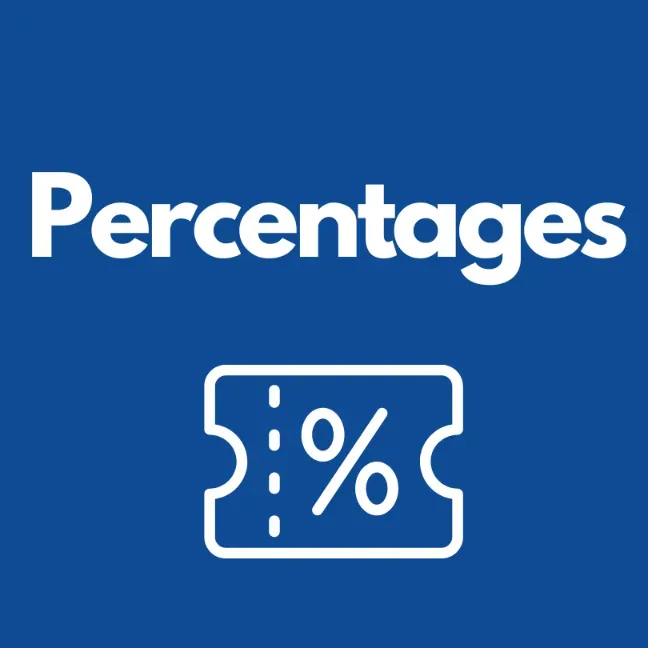Percentage Change Calculator
Enter two values to calculate the % change
Related Percentage Calculators
See all maths calculators
Percentage Change Calculator Guide
The Percentage Change Calculator is a valuable tool that allows you to determine the percentage difference between an initial value and a final value. This comprehensive guide will walk you through the process of using such a calculator, explain the concepts behind percentage change, provide practical examples, and offer insights into common pitfalls and real-world applications.
Understanding Percentage Change
Before diving into the calculation process, let's clarify some key concepts:
Percentage Change
Percentage change is a way of expressing how much a quantity has increased or decreased in relation to its original value. It is commonly used to compare changes in financial data, scientific measurements, and other numerical values.
Formula for Percentage Change
The basic formula for calculating percentage change is:
\text{Percentage Change} = \left(\frac{\text{Final Value} - \text{Initial Value}}{\text{Initial Value}}\right) \times 100
Calculating Percentage Change
To calculate the percentage change between two values:
- Subtract the initial value from the final value.
- Divide the result by the initial value.
- Multiply by 100 to convert to a percentage.
For example, to calculate the percentage change from 50 to 75:
- 75 - 50 = 25
- 25 \div 50 = 0.5
- 0.5 \times 100 = 50%
Therefore, the percentage change from 50 to 75 is 50%.
Examples of Percentage Change Calculations
Let's look at a table of examples:
| Initial Value | Final Value | Calculation Process | Percentage Change |
|---|---|---|---|
| 100 | 150 | $$(150 - 100) / 100 \times 100$$ | 50% |
| 200 | 180 | $$(180 - 200) / 200 \times 100$$ | -10% |
| 50 | 75 | $$(75 - 50) / 50 \times 100$$ | 50% |
| 80 | 60 | $$(60 - 80) / 80 \times 100$$ | -25% |
| 30 | 45 | $$(45 - 30) / 30 \times 100$$ | 50% |
| 120 | 120 | $$(120 - 120) / 120 \times 100$$ | 0% |
Common Mistakes to Avoid
When using a Percentage Change Calculator, be aware of these common pitfalls:
-
Confusing increase with decrease: Ensure you correctly identify whether the final value is greater or less than the initial value.
-
Misplacing decimal points: Be careful when dividing and multiplying by large numbers.
-
Forgetting to multiply by 100: Remember that percentage change is expressed as a percentage, so you must multiply by 100.
-
Ignoring negative results: A negative percentage indicates a decrease, while a positive percentage indicates an increase.
-
Incorrectly interpreting zero change: A result of zero means there was no change between the initial and final values.
Practical Applications
Understanding how to calculate percentage change has numerous real-world applications:
Finance and Investing
Percentage change is commonly used to track stock prices, investment returns, and financial performance.
Example: If a stock price increases from $100 to $120, the percentage change is 20%, indicating a positive return on investment.
Retail and Sales
Businesses use percentage change to analyze sales growth or decline over time.
Example: If sales revenue decreases from $5000 to $4500, the percentage change is -10%, indicating a decline in sales.
Science and Research
Scientists use percentage change to measure changes in experimental data or natural phenomena.
Example: If the temperature of a solution increases from 20^\circ C to 25^\circ C, the percentage change is 25%.
Health and Fitness
Percentage change can be used to track progress in weight loss or fitness goals.
Example: If a person loses weight from 200 pounds to 180 pounds, the percentage change is -10%.
Real World Analogies (RWA)
To better understand percentage change, consider these real-world analogies:
-
Shopping Discounts:
- If an item originally priced at $40 is now $30, the price has decreased by 25%.
-
Population Growth:
- If a town's population grows from 10,000 to 12,000, it has increased by 20%.
-
Fuel Efficiency:
- If a car's fuel efficiency improves from 25 mpg to 30 mpg, it has increased by 20%.
-
Academic Performance:
- If a student's test score improves from 70% to 85%, it has increased by approximately 21.43%.
These real-world analogies help to ground abstract percentage change concepts in concrete, everyday situations, making them easier to understand and remember.
Using Technology: Percentage Change Calculators
While it's important to understand the concept, Percentage Change Calculators can quickly perform calculations for complex data sets or when precision is needed beyond simple mental math. When using such calculators:
- Verify the input format required by the calculator.
- Double-check your entries for accuracy.
- Understand the output format provided by the calculator (decimal places).
- Use the results judiciously, especially in professional or academic contexts where showing your work may be required.
The Importance of Understanding Percentage Change
Understanding percentage change is crucial for various fields including finance, retail, science, and health. It provides insights into trends and patterns over time and helps make informed decisions based on quantitative data.
Conclusion
Using a Percentage Change Calculator to determine the percentage difference between an initial and final value is a valuable skill that enhances your ability to analyze trends and make data-driven decisions. Whether you're tracking financial performance, measuring scientific data changes, or monitoring personal progress, understanding percentage change can improve your analytical capabilities and problem-solving skills.
Remember, while calculators are powerful tools, understanding the underlying concepts is crucial. Practice manual calculations alongside using calculators to develop a deep understanding of how percentages reflect changes over time or across different scenarios.
Key Takeaways
- The formula for calculating percentage change is
(Final Value−Initial Value)/Initial Value × 100. - Be aware of common mistakes like confusing increases with decreases or forgetting to multiply by 100.
- Recognize practical applications in finance, retail sales analysis science experiments health tracking etc.
- Use real-world analogies help better understand remember concept.
- While calculators helpful understanding manual process crucial developing mathematical intuition.
- Remember negative results indicate decreases positive results indicate increases zero result means no change occurred!
By mastering concept of calculating percent changes you'll have powerful tool at disposal understanding analyzing trends patterns various real-world scenarios!

